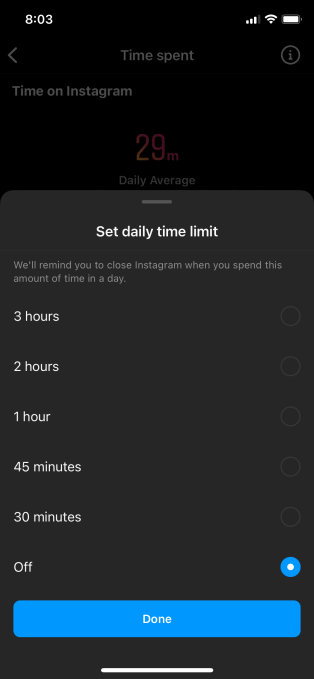RIP Mark Zuckerberg’s “time well spent“? In a move that appears to coincide with Facebook/Meta reporting slowing growth, photo-sharing app Instagram appears to have quietly removed the ability for mobile users to set a lower daily time limit reminder than 30 minutes.
Indeed, the app’s UX design nudges people to choose a three hour ‘limit’ (see screengrab below).
This daily time limit setting pops up a notification to the user once their app activity hits their preferred limit, reminding them to be conscious of how much time they are spending on the app — and maybe making it easier for them to choose to quit out of the app voluntarily.

Instagram’s daily time limit setting puts “3 hours” in the top slot — burying lower available limits (Screengrab: TechCrunch)
Previously the company supported a user-defined limit for Instagram that could be as low as 15 minutes — or even 10 minutes — per day, when it was making a big PR push to suggest that more ‘mindful’ usage of its services was possible, as concern over social media addiction surged.
But it seems the attention-loving adtech giant now wants Instagram users to spend longer eyeballing content feeds on the photo- and video-sharing platform where it can cash in by targeting them with ads. Which could be a result of pressure from the business side to eke out growth…
In its earnings earlier this month, Meta reported flat quarter-over-quarter usage for its eponymous app (Facebook) — and near flat growth for its other apps, which it wraps into a “family of apps” moniker, rather than breaking out Instagram, WhatsApp etc usage individually. (Daily active users of this ‘other apps’ category rose from 2.81BN in Q3 to 2.82BN in Q4; while monthly active users rose from 3.58BN in Q3 to 23.59BN in Q4; but usage of Facebook itself stayed entirely flat, quarter-over-quarter, at 1.93BN DAUs and 2.91BN MAUs.)
The disappointing Q4 results wiped 20% off the company’s value when they hit — which could be one reason why Meta’s growth teams may be seeing what levers they can tweak to drive engagement from existing users.
TechCrunch was alerted to the Instagram settings change by an tipster who shared screenshots of their account (see pics below) which show the company nudging them to “set a new value for your daily limit” — because, as it puts it, “the available daily limits are changing as part of an app update”. (Full marks to Meta for penning a sentence that fails to contain any meaningful explanation of why it’s making arbitrary changes to limit users’ control.)
This user had previously specified a 10 minute daily limit. However they’re now suddenly being informed this option is no longer available — and, presumably, any users who had not yet specified a daily limit or had picked a different (higher) limit would be unlikely to even realize that the 10 minute option had been deprecated.
And while Instagram’s notification to the user of this change to daily limits does state that they can retain their current 10 minute limit, the app uses blatant dark patterns to nag them into changing it — including by popping up a notification right above the 10 minute limit that’s indicated on their “time on Instagram” settings page, which further instructs: “This value is no longer supported. Please edit” — all of which is clearly designed to make them think they do actually have to switch to a higher limit.
“My choice has gone away, and if I try and change it, my old minimum of 10 minutes triples to 30 minutes as the new minimum,” the tipster told TechCrunch.
The source, who preferred to remain anonymous, likened this silent switch to “a tobacco company saying you can limit your packs a day, as it takes away smaller packs”.
“They don’t force the change but if go into the edit screen as it tells you to, then you have to force quit the app to get out without changing it,” they added.
We’ve recently seen Facebook/Meta using a similarly manipulative persistent notification tactic when trying to push a policy update on WhatsApp users in the face of a major T&Cs backlash — which has led to an (ongoing) consumer protection probe in the EU. But the company has a long, ignoble history of this sort of stuff. So none of this is surprising. But ofc that doesn’t make it okay.
It’s getting harder for companies like Meta to pull the wool, though. Oversight bodies are wising up to dark patterns. See for example — again in European Union — lawmakers in the parliament who recently overwhelmingly backed putting explicit restrictions on such manipulative tactics into upcoming rules set to apply widely to digital platforms.
So the scope for platforms to profit off of cynically self-serving defaults (or “available” settings) looks to be shrinking.
Our tipster wasn’t sure exactly when the 10 minute option they had been able to select previously was discontinued — but they told us the app had been “nagging for a couple of weeks” to press them to “edit” the setting.
We also checked what we could see ourselves to confirm this change applied more widely than to a single Instagram user — and found that 30 minutes seems to be the new ‘norm’ for app users.
A US-based TechCrunch reporter found the app also only offers them 30 minutes as the lowest available daily limit.
As with the tipster, the top option this user was presented with in the list of available times — and thus the option they’re most likely to notice, from a UX design point of view — was “3 hours” (aka 6x 30 minutes).
Another UK-based TCer who checked their app could also only select 30 minutes as the lowest daily limit for the notification on their Instagram.
Interestingly, the picture looked different on the Facebook mobile app. There the options offered to a TechCrunch reporter based in France technically included “0 hours, 0 minutes” — although that did not work when selected. However they were able to select a 5 minute limit (rising in 5 minute increments thereafter) so it looks as if the 30 minute minimum may not have been applied to the Facebook mobile app by Meta (yet).
We were also able to confirm that another UK-based Facebook mobile app user could select a 5 minute minimum on that app.
We asked Meta to confirm any changes it has made to the Instagram daily limits setting — as well as putting a number of other related questions to it — but at the time of writing the company had not responded.
The company finally sent a statement — around 11 hours after we asked about this; it was a US holiday today but this delay does underline how another of Meta’s “global” platforms remains locked to US-based comms and US-centric decisions — see the bottom of this post for the statement and our update.
Facebook garnered a lot of press back in 2018 when, with concern surging over the impact of social media platforms on teenagers’ mental health — it announced it was giving Instagram and Facebook users new “time management tools” — which included the ability to set a (soft) daily time on usage. Users would also be able to view a daily average of time spent on the mobile app, based on a week’s usage.
“We want the time people spend on Instagram and Facebook to be intentional, positive and inspiring,” Ameet Ranadive, product management director at Instagram and David Ginsberg, director of research at Facebook, wrote as they introduced the bundle of time management features. “Our hope is that these tools give people more control over the time they spend on our platforms and also foster conversations between parents and teens about the online habits that are right for them.”
The feature launch was linked to a wider company push — starting around 2017 — when it appeared to engage publicly with concerns about the negative impacts of social media.
However Facebook did so by seeking to reframe the narrative by suggesting any problems with usage are incremental and manageable (i.e. rather than existential for its attention-dependent business) — just so long as the user has “tools” to support what it dubbed “meaningful social interactions”.
Hence the flotilla of tweaks and “controls” Facebook/Meta went on to announce — offering self-serving ‘fixes’ to address societal concerns about social media usage, with the aim of preventing users actually stopping the habit entirely.
Of course these controls rarely — if ever — actually put users in control. Moreover the underlying content ranking algorithms actively undermine user autonomy by optimizing for profit-maximizing ‘engagement’ — as Facebook whistleblower, Frances Haugen, went on to detail in hours of detailed testimony to lawmakers last year.
The Instagram daily time limit feature, for example, was a lot more mindfulness theatre than meaningful control right from the get go — since users just got a notification if/when they reached their desired daily time, rather than the app taking firmer action like actually locking them out until the next day.
As Haugen has testified, Facebook has demonstrated a systematic unwillingness to give up little slivers of profitability in service of a greater good (aka the welfare of its users/society) — up to and including, it now seems, letting Instagram users select a 10 minute soft limit on their usage. Which would allow for fewer ads to be served vs a 30 minute minimum — which means less profit for Meta…
So the company’s claim of trying to deliver ‘time well spent’ on its platforms looks to have past its sell by date: Another hollow publicity stunt to buy Fb time while its growth teams drum up new UX hacks to keep the eyeballs busy.
(On the flip side, it’s interesting to consider the recent popularity of viral word game, Wordle, whose creator suggested it should only be played for three minutes a day when he spoke to the BBC last month — while the app itself hard-limits the game to one puzzle per day.)
In any case, the debate about regulating powerful tech platforms has moved on considerably since 2017 — with tech giants like Meta now facing the prospect of hard limits on how they can operate, via incoming regulation such as the EU’s Digital Markets Act. Or the UK’s Age Appropriate Design Code which seeks to safeguard the welfare of children by enforcing strict privacy defaults and standards, and imposing other restrictions such as time limits on when platforms can message child users.
So if the secret of your ad-platform’s growth is dark pattern design and manipulative messaging — not to mention anti-competitive surveillance — then your investors do, certainly, have reasons for concern.
Update: In the statement responding to our questions, Meta claimed the removal of “daily limit” limits that are shorter than 30 minutes is related to the launch of newer time management feature, which it calls “Take A Break” — saying it wanted to avoid sending people multiple notifications at the same time.
Here’s the statement in full:
“We have two time management features. Our existing ‘daily limit’ shows you a notification when you’ve hit your daily limit, but our newest feature ‘Take A Break’ shows you full-screen reminders to leave the app, and includes 10 minute intervals. We changed the ‘daily limit’ options to avoid sending people multiple notifications at the same time.”
This raises a number of new questions — such as why Instagram’s notifications to our tipster, nudging them to set a new (higher) daily time limit than 10 minutes, did not at the very least inform them of (or even link them to!) the existence of the Take A Break feature?
And why a setting that is marketed as providing users with greater control over their Instagram usage should — in practice — lead to a user feeling they like have less control, given it keeps nudging them to remove their self-selected time limit without properly informing them of relevant alternatives.
In any case, the wider point about shape-shifting, self-serving settings is that ever iterating user controls which require users to track incremental platform updates in full dimension detail do the polar opposite of putting users in control.
Instead the person whose settings have, yet again, being reset or otherwise reconfigured must constantly work to understand the updated ‘version’ of control they are now being offered — at the very least learning to navigate a new menu interface. And if they don’t do that — say they feel too tired to do the research required to grok yet another finicky settings change — they risk being reset back to a lower level of control vs what they may have previously specified.
Facebook has infamously used this tactic with privacy settings over its long years of user-hostile design choices — notoriously flipping access to content that users had expressly told it should remain limited to being viewable by “friends only” (for example) to opening access to make their stuff entirely public on a totally global service.
Damaging, resetting defaults and function-shifting settings are the very bread and butter of dark pattern design.
“Take A Break” slots neatly into this ignoble tradition.
It appears to have been first mentioned by Instagram back in a September 2021 blog post — when the company wrote that the feature had “tentatively” been given that name; and said the idea for it is to enable users to “put their account on pause and take a moment to consider whether the time they’re spending is meaningful”. (The blog post did not actually specify what “Take A Break” would do. God forbid the company were to actually inform its users in plain English how something works!)
Understanding these ever iterating new features — or new user control mechanisms, as they really are — is typically left to the tech press. Which means many publications generate a lot of coverage simply by explaining the nuance.
This is often very helpful to Meta from a PR point of view, given it can routinely expect huge attention to the quotidian detail of incremental feature tweets/launches — which works to suck the oxygen out of the room/detract attention from more meaningful critiques of the platform giant — like why Zuckerberg continues to have absolute monarchy levels of power over what Meta does via his majority voting shares; or whether Meta’s tools are busy right now whipping up another ethnic massacre.
But back to the detail of “Take A Break”.
Instead of a simple setting that notifies users when their app usage hits their self configured limit — and maybe offers them a single, big red button to ‘Close App’ — Take A Break offers a far more staged and controlled version of the concept of a usage limit. At a glance, this looks mostly intended to quickly convince the user to return to the comfort of passive scrolling in the app, owing to a curated selection of alternative suggestions Meta presents in bolder, darker text (vs only a faint grey text where it suggests they “take a moment to reset by closing Instagram”).
CNN covered Take A Break in a video back in December — and the listed suggestions that appear in its video don’t seem optimized to actively discourage more content grazing in its app. Far from it. Some indeed may have the opposite effect (“do something on your to-do list”, for example, sounds a helluva a lot like work; while “take a few deep breaths” sounds like something you could literally spent a few seconds doing and then feel as if that’s job done, break over and back to scrolling on Instagram…
Additionally, as CNN’s reporter pointed out, the feature’s 10 minute limit is sneaky. It is not a hard limit on daily usage — it’s merely a resetting pop up that ultimately encourages you to close it and go back to the app like every other tedious pop-up that the data industrial adtech complex routinely (and — at least in Europe — illegally) sicks onto the web.
And if you do take Instagram up on one of the listed “Take A Break” suggestions, and actually switch away from the app — say so you can fire up Spotify to “listen to your favorite song” — Meta wins again because the app’s break counter resets back to zero! So it’s not actually a daily 10 minute limit at all!
Really, “Take A Break” is a very different, far more manipulative feature than “Daily Limit” — one that looks intended to groom users into feeling as if they’re taking a break while simultaneously working to minimize how much time they actually stop using the app. A few breaths of ‘time out’ or a couple of seconds “writ[ing] down what you’re thinking” — or even a minute or two listening to a pop song — is all Meta says your eyeballs need before it serves up the next batch of ads.
Frankly you can’t reform this level of dark pattern.
The cynicism is so utterly pitch it should have its own event horizon.
Powered by WPeMatico






